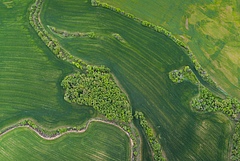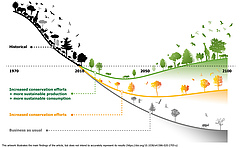Bending the curve of biodiversity loss

Natural habitats that support high biodiversity are increasingly under pressure from agricultural land use. (Picture: Juan Carlos Munoz / Adobe Stocks)

The downward trend of global biodiversity can still be bent around, but achieving this soon requires effective policies to not only conserve and restore biodiversity but also to limit global demand for agricultural commodities and the environmental impacts of producing them. (Picture: IIASA)
How biodiversity could be preserved globally without sacrificing necessary production output
Based on a press release by the International Institute for Applied Systems Analysis (IIASA)
Laxenburg/Leipzig. Ambitious, integrated action combining conservation and restoration efforts with a transformation of the food system. This is the recipe for turning the tide of biodiversity loss by 2050 or earlier, a new study led by the International Institute for Applied Systems Analysis (IIASA) with participation of researchers from the German Centre for Integrative Biodiversity Research (iDiv) suggests. Using multiple models and scenarios, the team investigated whether and how it might be feasible to improve the status of biodiversity while at the same time complying with other sustainability targets related to land use. The study was published in Nature and forms part of the latest WWF Living Planet Report.
Biodiversity – the variety and abundance of species, along with the extent and quality of the ecosystems they call home – has been declining at an alarming rate for many years due to human activity. While ambitious targets have been proposed in many different policy processes, practical issues such as feeding the Earth’s growing human population could make reaching such targets a challenge. The reason is that nature conservation and food production compete for the same areas.
A new study conducted by an international team of scientists led by IIASA and with participation of iDiv for the first time sets out to explore policy targets as ambitious as a reversal in global biodiversity trends and shed light on what integrated future pathways to achieving this goal might entail.
“We wanted to assess in a robust manner whether it might be feasible to bend the curve of declining terrestrial biodiversity due to current and future land use, while avoiding jeopardizing our chances to achieve other Sustainable Development Goals (SDGs),” explains study lead author and IIASA researcher David Leclère. “If this were indeed possible, we also wanted to explore how to get there and more specifically, what type of actions would be required, and how combining various types of actions might reduce trade-offs among objectives and instead exploit synergies.”
Using multiple models and newly developed scenarios to explore how addressing these elements in an integrated way might help reach biodiversity targets, the study provides key information on pathways that could materialize the 2050 vision of the UN Convention on Biological Diversity – “Living in harmony with nature”. For global trends of terrestrial biodiversity as affected by land-use change to stop declining and start recovering by 2050 or earlier, the researchers say that action is needed in two key areas:
- Bold conservation and restoration efforts together with increased management effectiveness, will have to rapidly be stepped up: The study assumes that protected areas quickly reach 40% of global terrestrial areas. This should happen in tandem with large efforts to restore degraded land (reaching about 8% of terrestrial areas by 2050 in the study scenarios) and land use planning efforts that balance production and conservation objectives on all managed land. Without such efforts, declines in biodiversity may only be slowed down rather than halted and any potential recovery would remain slow.
- Food system transformation: As bold conservation and restoration efforts alone will likely be insufficient, additional measures are needed to address global pressures on the food system. Efforts to bend the curve of global terrestrial biodiversity include reduced food waste, diets that have a lower environmental impact, and further sustainable intensification and trade.
Integrated action would however need to be taken in both areas simultaneously to bend the biodiversity loss curve upward by 2050 or earlier.
In a scenario with increased conservation and restoration efforts alone, almost half of biodiversity losses estimated in the counterfactual business-as-usual scenario could not be avoided. A bending was not observed for all models, and when it did occur, it was often only in the second half of the 21st century. In addition, the researchers found that bold conservation and restoration efforts alone might increase the price of food products, thereby potentially hampering future progress on eliminating hunger.
Conversely, scenarios that combined increased conservation and restoration efforts with efforts to transform the food system showed that opportunities for ambitious conservation and restoration efforts were larger, and potential adverse food security impacts defused, thereby securing a bending of global trends in global terrestrial biodiversity as affected by land use change by 2050.
“Finally, such transformative change in food and land use systems would also deliver significant co-benefits,” says Carsten Meyer, iDiv researcher and coauthor of the study. “For example, this would significantly contribute to ambitious climate-change mitigation targets, reduced pressure on water resources, reduced excess of reactive nitrogen in the environment, and health benefits.”
As the CBD is currently developing a new Strategic Biodiversity Plan to 2030, the study’s findings are directly relevant to on-going negotiations at the United Nations Convention on Biological Diversity.
“Our results can be regarded as a very positive message to current negotiations about new biodiversity targets,” says Meyer. “At the same time, they show clearly, that this cannot possibly be achieved through classical conservation instruments such as ecosystem protection and restoration alone, but will additionally require extensive supply-side and demand-side measures in the food and bioenergy sectors to effectively reduce their total land footprints, especially in highly biodiverse regions.”
Original publication
(Scientists with iDiv affiliation bold)
Leclere D, Obersteiner M, Barrett M, Butchart SHM, Chaudhary A, De Palma A, DeClerck FAJ, Di Marco M, et al. , incl. Meyer, C. (2020). Bending the curve of terrestrial biodiversity needs an integrated strategy. Nature. DOI: 10.1038/s41586-020-2705-y
Contact:
Dr Carsten Meyer
Head of Junior Research Group Macroecology and Society
German Centre for Integrative Biodiversity Research (iDiv)
Halle-Jena-Leipzig
Leipzig University
Phone: +49 341 9733238
Email: carsten.meyer@idiv.de
Web: www.idiv.de/en/groups_and_people/employees/details/371.html
David Leclère
Research Scholar
IIASA Ecosystems Services and Management Program
Phone: +43 2236 807 597
Email: leclere@iiasa.ac.at
Sebastian Tilch
Media and Communications
German Centre for Integrative Biodiversity Research (iDiv) Halle-Jena-Leipzig
Phone: +49 341 97 33197
Email: sebastian.tilch@idiv.de
Web: www.idiv.de/en/media
